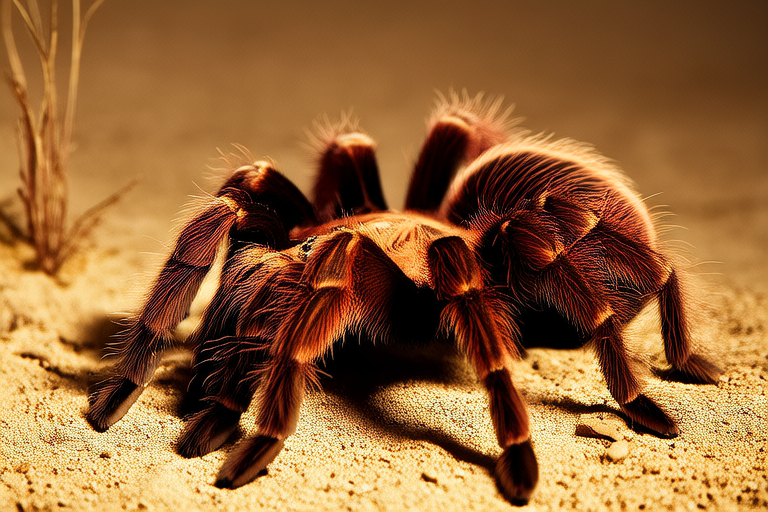Chilean Rose Tarantulas: Perception and Care
The Chilean rose tarantula (Grammostola rosea) is one of the most popular pet tarantulas due to its striking appearance and relatively docile nature. Despite its intimidating looks, this spider is known for its calm demeanor, making it an ideal choice for beginners and experienced arachnologists alike. This article explores the contrasting perceptions of the Chilean rose tarantula, addressing its often intimidating appearance versus its docile temperament, providing insights into its care, common misconceptions, and behaviors.
The Intimidating Appearance
The Chilean rose tarantula has a unique and captivating appearance that can be both beautiful and frightening. It is named for its pinkish-hued legs and abdomen, which contrast with its darker carapace. The spider’s long, hairy legs and large fangs can be quite intimidating to those unfamiliar with tarantulas. Its size, typically reaching up to 4 inches in length, also contributes to its imposing presence. Additionally, tarantulas have the ability to release urticating hairs from their abdomen when threatened, which can cause irritation to predators or handlers.
The Docile Temperament
Despite its fearsome appearance, the Chilean rose tarantula is renowned for its calm and gentle nature. Unlike many other spiders, it rarely displays aggressive behavior towards humans. In fact, it is one of the most docile tarantulas available as pets. They are generally slow-moving and prefer to avoid confrontation, making them ideal for handling by experienced keepers. However, it is important to handle them with care and respect, as they may become stressed if mishandled.
Care and Maintenance
Providing the appropriate habitat and care is crucial for the health and well-being of a Chilean rose tarantula. These spiders require a terrarium that mimics their natural environment, including proper substrate, temperature, and humidity levels. A suitable enclosure should be at least three times the length of the spider, ensuring ample space for movement. The substrate can consist of coconut fiber, peat moss, or a mixture of both, which helps maintain the necessary humidity levels.
Temperature and humidity are vital factors in maintaining a healthy environment for the Chilean rose tarantula. The ideal temperature range is between 75°F and 85°F (24°C to 29°C), while the humidity should be kept around 60% to 70%. Providing a shallow water dish and occasional misting can help maintain these conditions. Additionally, a hide spot should be included in the enclosure to offer the spider a secure place to retreat when needed.
Common Misconceptions
There are several common misconceptions about Chilean rose tarantulas that can lead to misunderstandings about their care and behavior. One prevalent myth is that all tarantulas are highly venomous and dangerous. While it is true that tarantulas possess venom, the venom of the Chilean rose tarantula is generally not harmful to humans. Their bites are usually no more painful than a bee sting and are primarily used for subduing prey.
Another misconception is that tarantulas are solitary creatures that cannot be housed together. While it is true that adult Chilean rose tarantulas are typically solitary, younger specimens can sometimes be kept together in groups. However, it is essential to monitor them closely, as conflicts may arise as they mature. Additionally, it is important to provide each spider with its own enclosure to prevent stress and potential injuries.
Behavioral Insights
Understanding the behavior of the Chilean rose tarantula can help owners provide a more enriching environment for their pets. These spiders are primarily nocturnal, meaning they are most active during the night. They spend much of their time resting in their hide spots during the day and emerging to hunt for food at night. In the wild, they feed on insects such as crickets, mealworms, and wax moths. In captivity, a varied diet of appropriately sized insects can help ensure optimal nutrition.
The Chilean rose tarantula’s molting process is another fascinating aspect of its behavior. Molting, or ecdysis, is the process by which the spider sheds its exoskeleton to grow. During this time, the spider will remain in its hide spot and may refuse food. It is essential to provide a humid environment during molting to facilitate the process. After molting, the spider will absorb its old exoskeleton and may remain vulnerable for several days.
Tips for Handling
Handling a Chilean rose tarantula requires patience, caution, and respect. Always wash your hands before and after handling the spider to avoid transferring oils or chemicals that could harm it. Gently pick up the spider by placing your hand near its abdomen and allowing it to climb onto your hand. Avoid touching the spider’s legs or abdomen, as this can cause distress. It is also important to handle the spider only occasionally, as frequent handling can lead to stress and potentially affect its health.
Conclusion
The Chilean rose tarantula is a fascinating and rewarding pet for those interested in exotic animals. Its striking appearance and docile temperament make it an excellent choice for both beginners and experienced keepers. By understanding its care requirements, dispelling common misconceptions, and appreciating its unique behaviors, owners can provide a safe and enriching environment for their Chilean rose tarantulas. With proper care and attention, these spiders can thrive in captivity and bring joy to their human companions.
